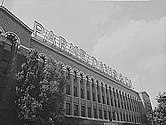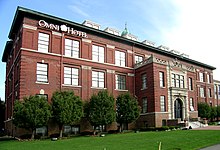Parke-Davis
| Parke-Davis
|
|
|---|---|
| legal form | Association of persons |
| founding | 1866 |
| Reason for dissolution | sale |
| Seat |
Detroit , United States |
| Branch | Pharmaceutical Industry |
Parke-Davis is a subsidiary of the pharmaceutical company Pfizer . Parke, Davis & Co. no longer exists as an independent company, but was at times the largest and oldest drug manufacturer in America. In 1970 the company was bought by Warner-Lambert , which in turn was bought by Pfizer in 2000.
history
Parke, Davis and Company was founded in Detroit , Michigan by doctor and pharmacist Samuel P. Duffield. In 1860 Duffield owned a small pharmacy at the intersection of Gratiot and Woodward Avenues. Duffield made various pharmaceutical preparations such as pain relievers and mercury ointment.
Duffield and Hervey Parke entered into a partnership in October 1866, to which George S. Davis joined as a third partner in 1867. Parke was looking for business opportunities; Davis had sales experience. Duffield retired in 1869 due to health problems and an interest in the practice of medicine. The partnership took on the name Parke, Davis & Company in 1871 and registered it in 1875.
In 1871 the company sent expeditions to Central and South America and the West Indies in search of medicinal plants. The company produced the herbal laxative, Cascara sagrada , which was used by Native Americans in the Pacific Northwest.
Once the world's largest pharmaceutical company, Parke-Davis built the first modern pharmaceutical laboratory and developed the first systematic clinical trials for new drugs. The Parke-Davis Research Laboratory is a National Historic Landmark ; the surrounding Parke-Davis and Company Pharmaceutical Company Plant has been added to the National Register of Historic Places .
The manufacturing facility on Parkdale Road in Avon Township (now Rochester Hills ) was also a landmark and is now used by PAR Pharmaceuticals.
In the 1950s, Parke-Davis hired Jonas Salk as a vaccine consultant. Parke-Davis helped develop the polio vaccine. Salk first had to convince Parke-Davis to follow his production protocol closely. Parke-Davis had an exclusive contract for the production of the vaccine for field trials for six months, but the National Foundation for the prevention of Polio dissolved the contract in February 1954, so that production was also opened for other companies.
Parke-Davis commissioned the Detroit illustrator Robert Thom to create 40 images for the series "A History of Pharmacy in Pictures." Each image received an article in which the scene was explained and placed in the historical context. The series was published in 1957 in collaboration with the University of Wisconsin's Institute for the History of Pharmacy. Pharmacists should display the works in their stores. Thom made a similar series on the history of medicine.
In the case of Franklin v. Parke-Davis (2002), the company was accused of using illegal marketing methods , such as advertising the off-label use of the anticonvulsant Neurontin . The drug was only approved for use by patients with epilepsy , but was used for purposes unapproved by the Food and Drug Administration in 80% of the $ 1.8 billion cans sold in 2001 . In 2004 Pfizer admitted "Parke-Davis was aggressively marketing Neurontin illegally for unrelated conditions such as bipolar disorder, pain, migraine headaches, and drug and alcohol withdrawal," and agreed to a fine of $ 430 million, despite alleging the violations was committed as early as 1996, i.e. before Pfizer took over Warner-Lambert.
Pfizer closed its research facility in Ann Arbor, Michigan, as announced on January 22, 2007.
Products
One of the first Parke-Davis products was amylase isolated from Aspergillus flavus var. Oryzae by Takamine Jōkichi . The enzyme was originally intended for use in distilleries , but was marketed as "taka diastase" for dyspepsia .
Parke-Davis also sold Coley's toxin , developed by William Coley for the treatment of osteosarcoma , which was the first cancer vaccine. There was a distribution agreement with the Inoculation Department of St. Mary's (London), which is why vaccines against infectious diseases, acne and cancer were sold there.
Another of the company's products was pure adrenaline, also developed by Takamine. It was patented in 1900 and the name "Adrenalin" is protected. Due to the similarity to the English name "Adrenaline", the term "Epinephrine" has developed as an alternative name in the United States. Parke-Davis sued HK Mulford Company for infringement of the Adrenaline patent . The decision in favor of Parke-Davis by the judge Learned Hand is considered to be decisive for modern patent law.
Parke-Davis sold cocaine in a variety of forms including cigarettes, powders, and preparations for injection into a vein with a needle before it was banned. The company promised the cocaine products would "replace food, make cowards brave, silence talkative [...] and insensitive to pain." In October 1915, Aleister Crowley , author of Diary of a Drug Fiend and The Confessions of Aleister Crowley, visited Parke-Davis in Detroit: "[They] were kind enough to take an interest in my research on Lophophora williamsii and based my findings on some preparations that are far superior to the previous ones." Parke-Davis was also the manufacturer and patent holder of phencyclidine (PCP). The company developed ketamine hydrochloride , an anesthetic and dissociative , in 1962 .
Parke-Davis marketed the first drug for the treatment of epilepsy , Dilantin , which was approved in 1939. However, no one was involved in developing the ingredients or the form of application.
In collaboration with the Japanese Daiichi Sankyō and the British Glaxo Wellcome , Parke-Davis developed and marketed the antidiabetic drug Rezulin ( troglitazone ) at the end of the 1990s . In 2000 the drug was withdrawn from the market due to liver toxicity.
Parke-Davis developed the first bacterial vaccine . It was also one of the five companies that manufactured the polio vaccine developed by Jonas Salk . A combination of DPT and polio vaccine, called quadrigas , was developed in 1954 and approved 1959th Quadrup was withdrawn from the market in 1968 after several lawsuits related to side effects in vaccinated children. Parke-Davis also produced the broad spectrum antibiotic chloramphenicol , which was widely used until the danger of aplastic anemia became known.
The company also produced anti-infectives and birth control pills .
Individual evidence
- ↑ 2000: Pfizer Joins Forces With Warner-Lambert . Retrieved March 20, 2019.
- ^ A b c Milton L. Hoefle: The Early History of Parke-Davis and Company . In: Bulletin for the History of Chemistry . 25, No. 1, 2000.
- ↑ Jane S. Smith: Patenting the Sun: Polio and the Salk Vaccine . W. Morrow, 1990, ISBN 978-0688094942 , pp. 20, 218, 246.
- ^ The Norman Rockwell of Medicine . Retrieved March 20, 2019.
- ^ Purse, Marcia: Suit: Neurontin Marketed Illegally for Bipolar Disorder . VeryWell Min . 15th March 2019.
- ^ Huge penalty in drug fraud Pfizer settles felony case in Neurontin off-label promotion . San Francisco Chronicle . May 14, 2004.
- ^ Matthew Herper, At Pfizer, Brutal Cuts And Big Changes . In: Forbes . January 22, 2007. Accessed March 20, 2019.
- ↑ Bennett, Joan and Yamomoto, Yutaka: Dr. Jokichi Takamine: Japanese father of American Biotechnology ( Memento June 15, 2006). Deerland Enzymes .
- ↑ Kevin Brown: Penicillin Man: Alexander Fleming and the Antibiotic Revolution . The History Press, December 2005, ISBN 978-0750931533 .
- ↑ Lawrence Sutin: Do What Thou Wilt: a life of Aleister Crowley . Macmillan, September 14, 2000, ISBN 978-0312252434 , p. 253.
- ^ A Flaw in the System . remarkablemedicine.com Retrieved May 16, 2006.
- ↑ Bayly, M. Beddow: The Story of the Salk Anti-Poliomyelitis Vaccine. 1956.



